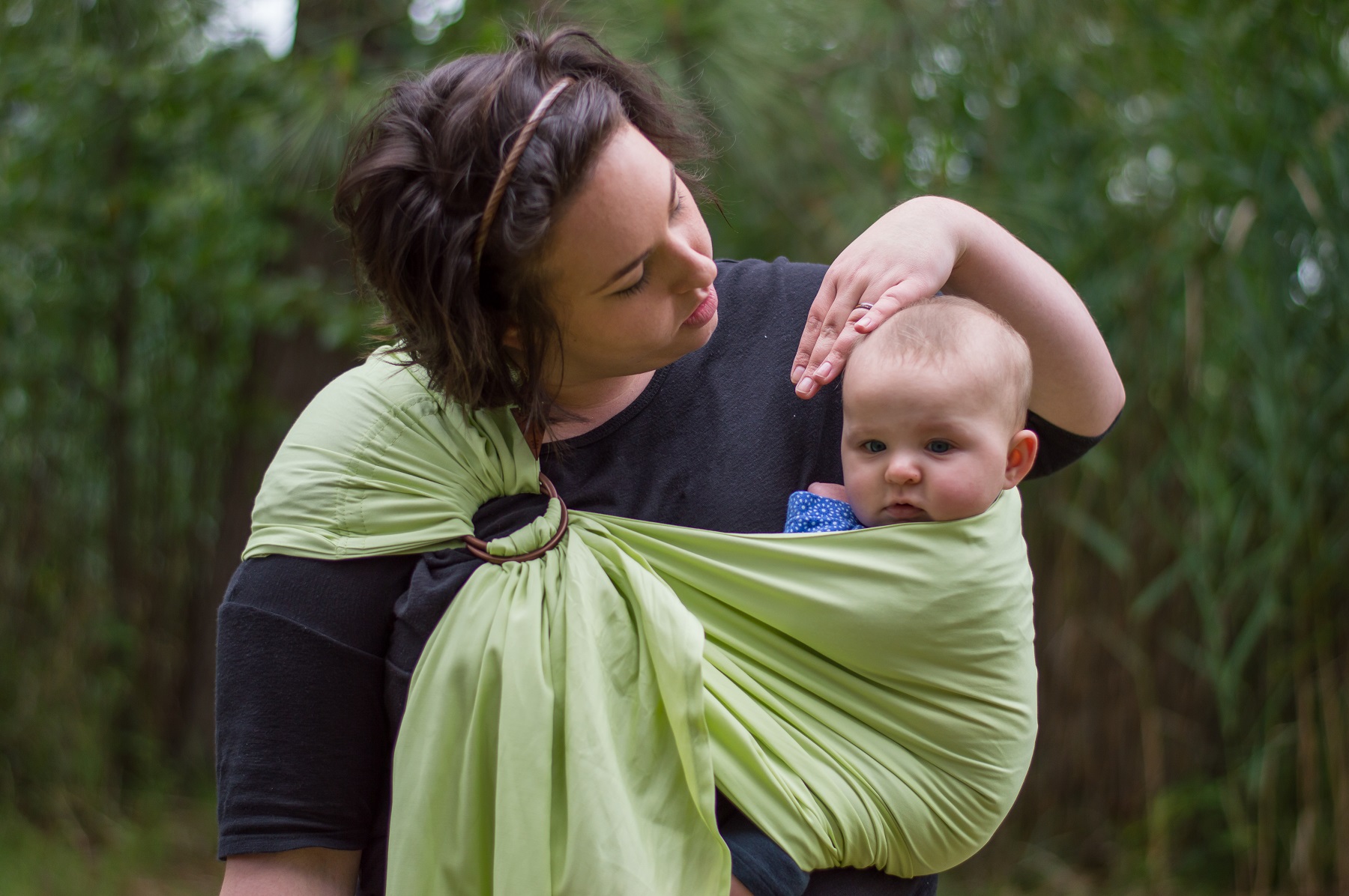It's on me, now what?Basic carrying positions
Tip: To check positioning with any new carry, consider how you would hold the baby in your arms. Then adjust the sling around your baby so that they stay in that same position. Newborns will naturally curl their legs into a "froggy" position. Until they start to uncurl, you may leave their legs inside the sling in this position, paying attention to their cues to prevent discomfort. For bigger babies, legs should straddle you as much as possible, as though riding a horse, and knees should be higher than bum. That's best for hip development, and keeps the baby from slipping out of the sling, since they are fully seated in the sling rather than just being held by a small ledge of fabric. Think of it as relaxing in a hammock, rather than perching on the edge of a stool.
Upright / heart to heart:For: newborn to toddler
This is the safest carry for newborns, and is wonderful for babies of any age. The chest to chest contact is soothing, and most babies prefer being upright to reclining in a cradle hold. A sleepy baby can rest their head on your chest, and an alert one can look around without tiring their neck.
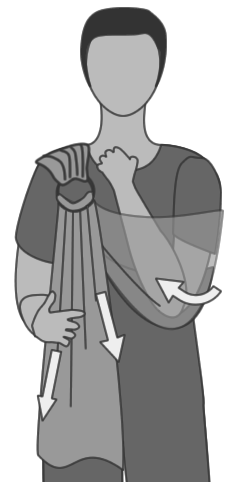
Preparation: Start with the bottom edge of the sling snug against your body, with almost no slack; for a newborn, make a pouch with the sling).
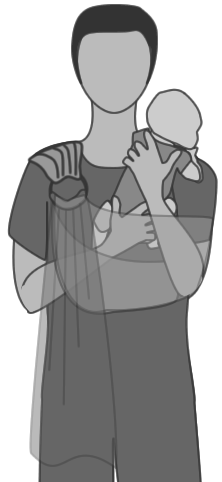
Hold baby on your shoulder opposite the rings, as though burping her. With your "ring side" hand under the fabric, guide her into the pouch of the sling, supporting her head with your other hand.
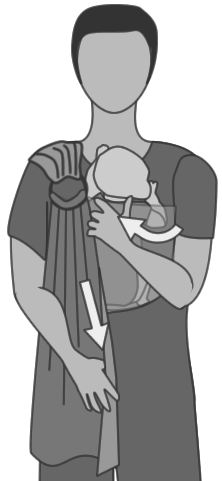
Tighten the sling by pulling fabric from your back around to your front, then pull the tail fabric towards your midline. This keeps the outer edges in place and prevents the rings from sliding down as you adjust the sling.
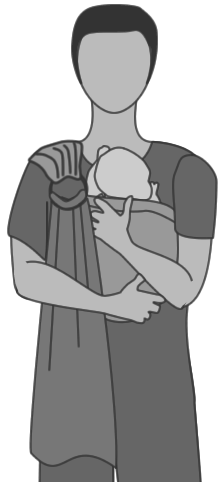
If the baby’s legs are inside the sling, be sure her weight rests on her bottom, not her feet, to prevent discomfort. See below for more information.
Legs in vs. out
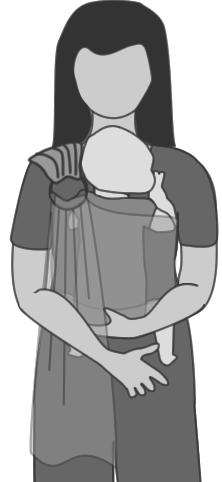 Whether to have your baby’s feet in the sling or out is up to you and your baby. It can be challenging to wear a newborn with feet out and still get a deep enough seat, but it can be done with practice. It’s fine to keep them in, as long as your baby’s weight is resting on her bottom, not her feet. If you are wearing with her feet out, her knees should always be higher than her bottom. In addition to being safer, this also keeps the sling from cutting into the backs of her thighs. If you feel you have to hold onto the baby after she is in the sling, there probably isn't enough of a hammock shape to the sling, or she may not be big enough to have her legs out. The body of the sling should be quite snug, to keep her from arching back, and her head should be close enough for you to kiss in this position. Most of the excess fabric should be under her knees, not on her back.
Whether to have your baby’s feet in the sling or out is up to you and your baby. It can be challenging to wear a newborn with feet out and still get a deep enough seat, but it can be done with practice. It’s fine to keep them in, as long as your baby’s weight is resting on her bottom, not her feet. If you are wearing with her feet out, her knees should always be higher than her bottom. In addition to being safer, this also keeps the sling from cutting into the backs of her thighs. If you feel you have to hold onto the baby after she is in the sling, there probably isn't enough of a hammock shape to the sling, or she may not be big enough to have her legs out. The body of the sling should be quite snug, to keep her from arching back, and her head should be close enough for you to kiss in this position. Most of the excess fabric should be under her knees, not on her back.
Hip carry:For: good head control to preschool
This is terrific for babies with head control all the way up through toddlerhood. Depending on your baby’s milestones (they should have consistent head control before you use this position) you will probably be able to start hip carrying her between 4 and 9 months.
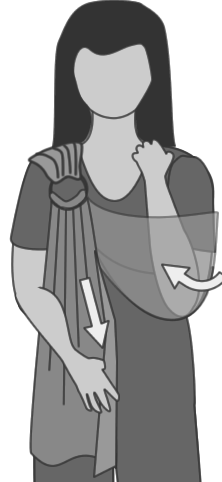
Tighten up the bottom of the sling to make a pouch for them to sit in, as you would for a smaller baby. For a bigger baby, hold your arm further from your body, to take up more space. Hold the child on your shoulder opposite the rings, as though you were going to burp them.
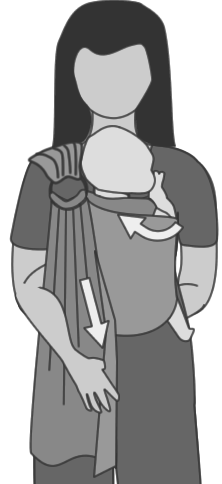
Keeping one hand on her bottom at all times, slide their legs into the sling. This is a little trickier with toddlers; you’ll need to bend their legs and tuck them in to the top of the sling.

Straddle their legs around your waist, as though you were carrying them without a sling. Their bottom should be a little lower than their knees, and the sling fabric should be snug behind their knees, like they’re sitting in a hammock. This way, their weight is held by their bottom, not their legs. Spread the fabric out over your child's back. If you are slinging an older baby or need to keep your toddler's hands contained, it should go over their shoulders.
Nursing in the upright or hip carries:
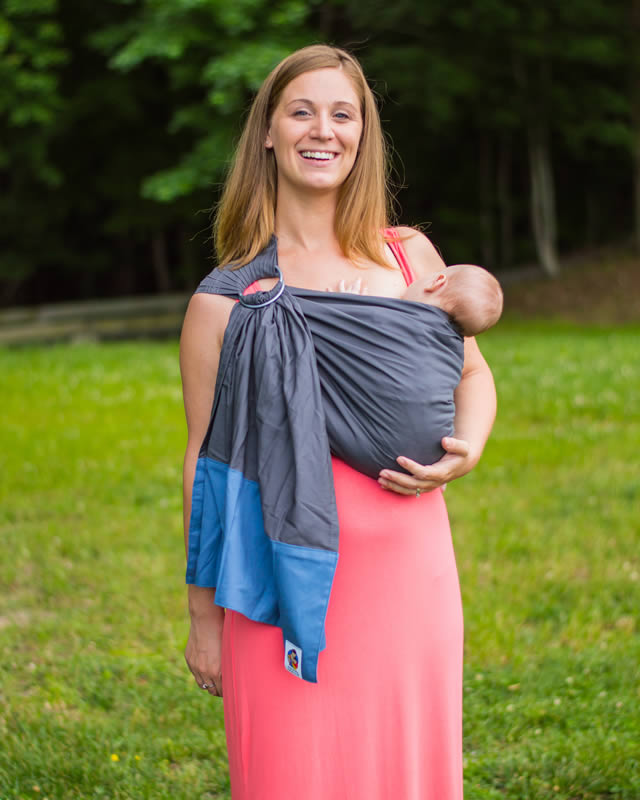 You can nurse a baby with good head control in these carries: just loosen the sling enough to lower the baby so they can comfortably reach your nipple. (If you have smaller breasts, you may not need to do anything else. For larger breasts, you may need to hold the breast up with your other hand, or use a soft prop to keep the breast at a comfortable level.) Do not attempt to nurse hands-free until your baby has sufficient head control to move away from the breast!
You can nurse a baby with good head control in these carries: just loosen the sling enough to lower the baby so they can comfortably reach your nipple. (If you have smaller breasts, you may not need to do anything else. For larger breasts, you may need to hold the breast up with your other hand, or use a soft prop to keep the breast at a comfortable level.) Do not attempt to nurse hands-free until your baby has sufficient head control to move away from the breast!
When adjusting, you will likely need to loosen the bottom edge more than the top edge, which should be fairly snug to keep his upper body secure.
When you are finished nursing, bring the baby’s head back up to kissing range by tightening the sling. NEVER leave your baby's face pressed against your breast after she has finished nursing, as this creates a risk of suffocation.
Next: Partial recline/cradle hold
